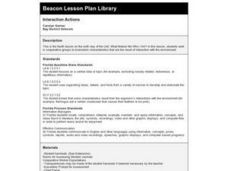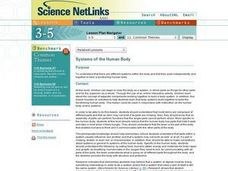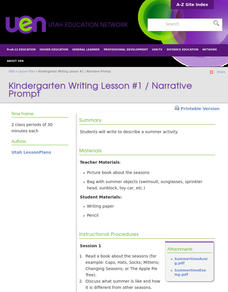Curated OER
Living Organisms
First graders investigate living things that are part of a class aquarium. They make observations and answer guided questions about each organism. Students read a Science textbook and engage in a class discussion about the content. Then...
Curated OER
Interaction Actions
Fifth graders, in groups, write about things that happen as a result of interacting with their environment.
Curated OER
Biology: Systems of the Human Body
Students examine the different systems of the human body and how they work independently and cooperatively. They complete sevral online interactive projects designed to reinforce how the systems work alone and together. Students make...
Curated OER
Gregory Carter
Pupils explore how the immune system, fights a war with a pathogenic organism: one of the many bacteria, viruses, and protozoans that can infect our bodies and cause disease.
Curated OER
English Exercises : Review of Common Types of Questions
In this online interactive English worksheet, students read a short passage and then respond to 10 multiple choice questions about the selection. Students may submit their answers to be scored.
Curated OER
Chemical Interactions
Students perform scientific investigations to observe chemical reactions. In this chemical reaction lesson students read a passage and identify the cause and effect.
Curated OER
Introducing Literary Elements in Fiction
Identify literary elements in fiction. In this reading comprehension lesson plan, learners read the book Pigsty and record literary elements onto a graphic organizer. They specifically discuss the main characters and events in the text.
Curated OER
Properties
In this properties activity, students classify each of the properties given as either extensive or intensive and as either physical or chemical. This activity has 1 graphic organizer and 8 fill in the blank questions.
Curated OER
The IMF In Action: Why Do We Need the IMF?
Students role play as a cell phone salesman who must solve trade issues. They examine how the International Monetary Fund gives assistance to countries with currency difficulties as they make decisions to solve their scenarios.
Curated OER
Organisms and Their Environment
Students explore Earth's biosphere. In this biosphere lesson plan, students participate in group activities regarding biotic and abiotic factors, population density, and species' habitats.
Curated OER
Yuckiest Site on the Internet
Students investigate the worm and the cockroach. In this organisms lesson, students visit suggested websites to identify the characteristics of worms and cockroaches. Students dissect a worm and observe a live cockroach. Students report...
Curated OER
Entering the Twilight Zone
Students describe major features of cold-seep communities and the process of chemosynthesis as it relates to organisms in each habitat. In this deep-sea habitats lesson plan, students study the categorization of ocean habitats according...
Consortium for Ocean Science Exploration and Engagement (COSEE)
One Ocean: It Matters!
Here is the first of four poignant lessons on how humans and oceans interact, even if people live far from the coast. This particular lesson also examines studies that are taking place in Antarctica of how climate change is affecting the...
Serendip
Using Models to Understand Cellular Respiration
Energize biologists with colorful images in an activity that captivates the imagination while demystifying the subject of cellular respiration. Participants build comprehension skills and access core content knowledge by analyzing text...
Earth Day Network
Staying Green While Being Clean
Clean up the environment with a lesson plan that focuses on replacing hazardous cleaning supplies with green, environmentally-friendly products. Using a dirty patch of surface as a control area, kids clean other parts of various surfaces...
Curated OER
Kindergarten Writing: Narrative Prompt
What is special about summer (fall, winter, or spring)? Using a bag filled with season-related items (for summer items like sunglasses, a swimming suit, etc.) the class take turns taking out one item. A discussion of how each item might...
Curated OER
Composting
Using 2-liter bottles, junior ecologists create composting tubes in which they place nitrogen-rich and carbon-rich materials. They observe what changes occur over two weeks' time. Provide more specific direction to your class as to what...
Curated OER
Classification: Dichotomous Key
Young scholars investigate the classification process and nomenclatures used for classifying organisms. They study dichotomous keys to identify organisms with 90% accuracy. Students organize information regarding the relatedness of species.
Curated OER
Analyzing Word Use Through Guided Wordle
Even though this lesson is just a basic way to review verb usage, it takes a novel approach. First, pupils identify verbs that they use too often in their writing, and then they create a Wordle. Wordle is a website that provides graphic...
Curated OER
We All Live Together
First graders examine the lifestyle of classroom and family pets in their natural habitat. They determine the needs of plants and animals, and how those needs are met. They listen to read alouds, sing songs, and draw using computer based...
Curated OER
Management Considerations
Students use a glossary of terms and a word search game to learn about mature adults. Thye interpret class rules and advanced organizer for the course. They recognize age-related terms and vocabulary.
Curated OER
The Wonderful World of Slugs
Examine a slug? Of course, what else would a 2nd grader do with it? Pupils use clues and go on a slug hunt, read a slug story, or make a cooperative group mural of a slug's habitat. While older learners catalog slugs, go on a slug hunt,...
Curated OER
Biosphere Starts with?
How can your pupils test their biosphere vocabulary acquisition? They can do it by using a fill-in-the-blank instructional activity like the one found here. Thirty-four common words and phrases surrounding the topic are included. There...
Curated OER
Viruses and Bacteria
A series of questions about archaebacteria and eubacteria reinforce a chapter on viruses and bacteria. This worksheet is from chapter 18 of an unspecified textbook, but could work with your biology lecture as well. High schoolers...

























